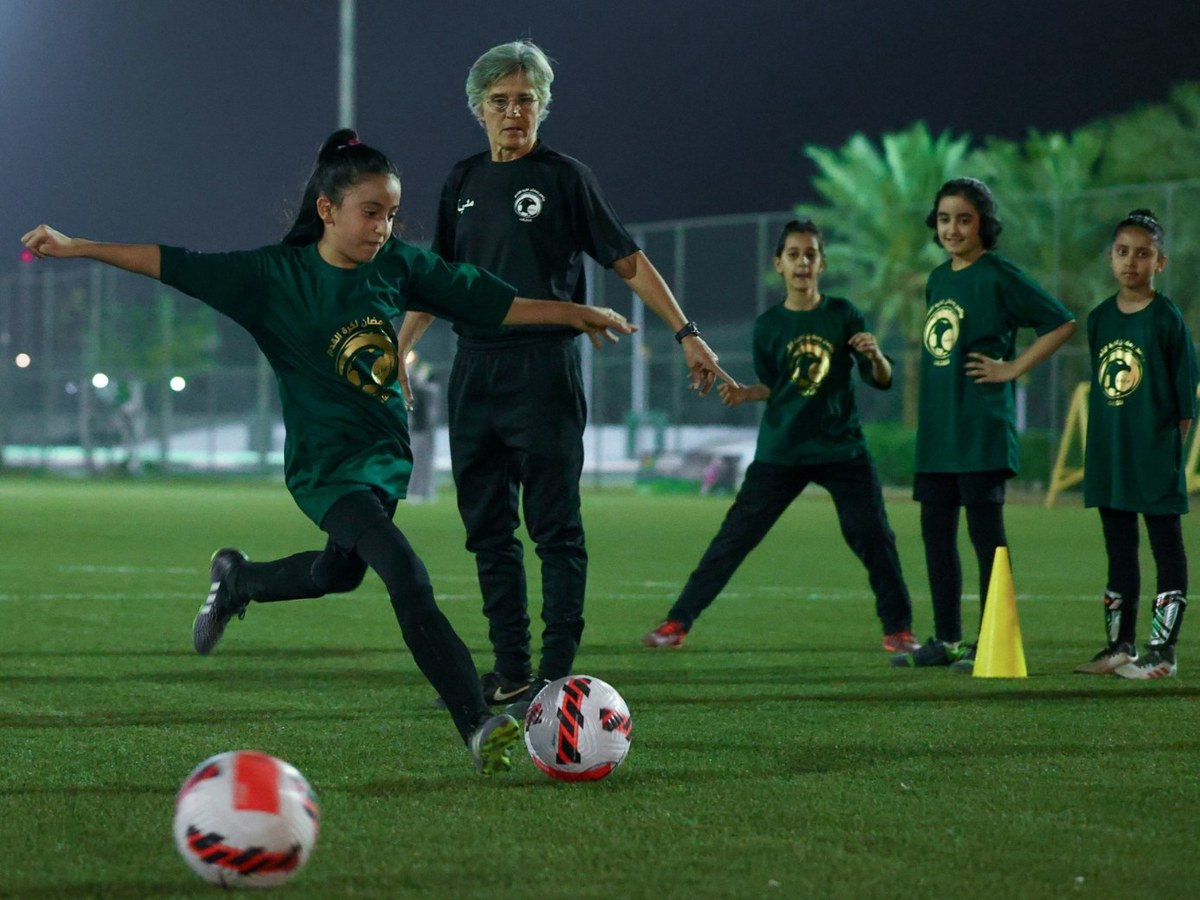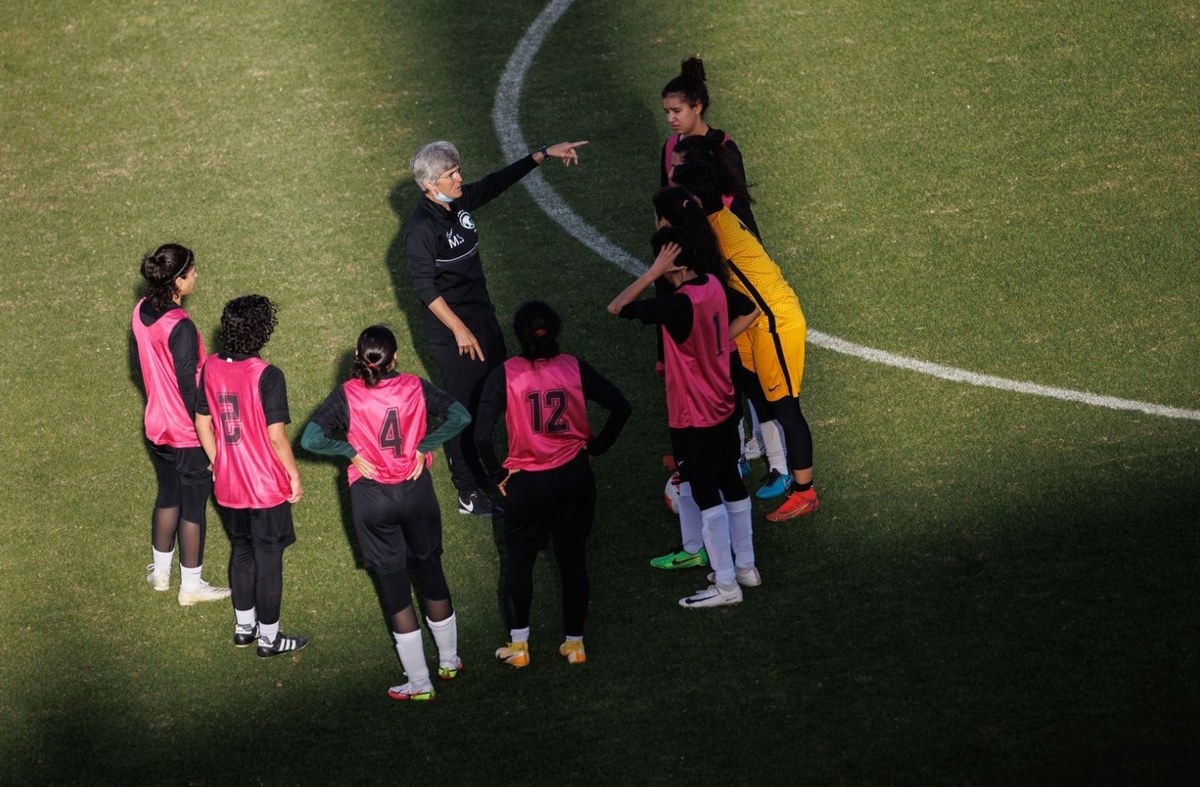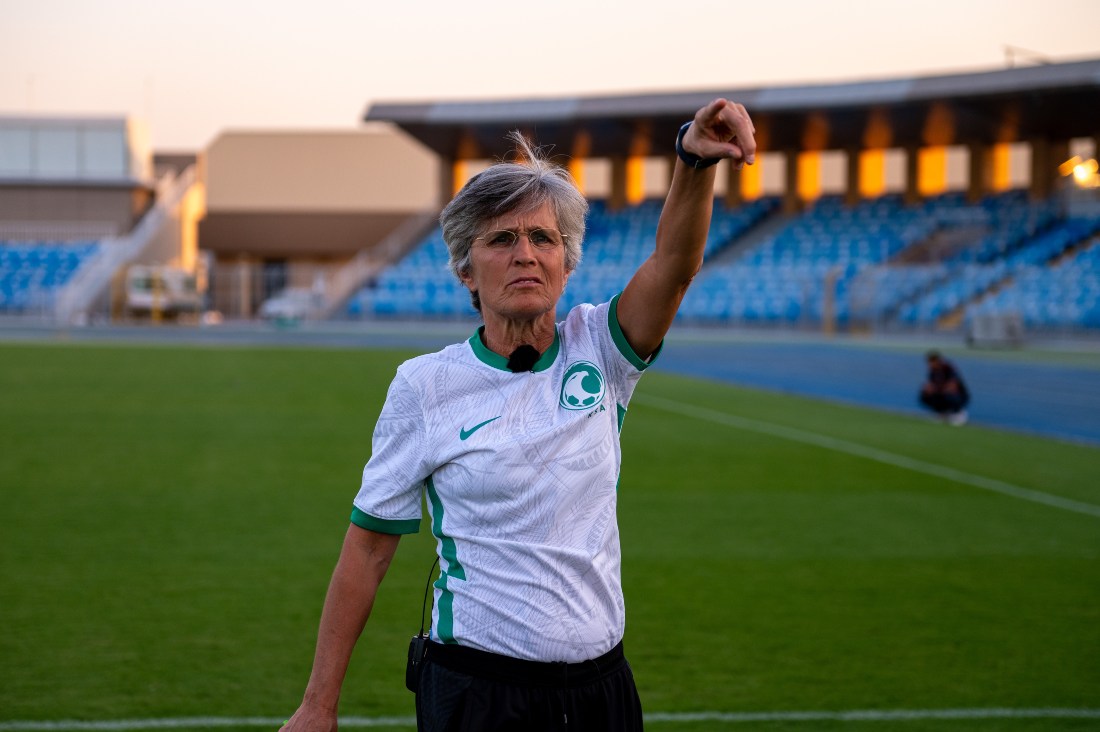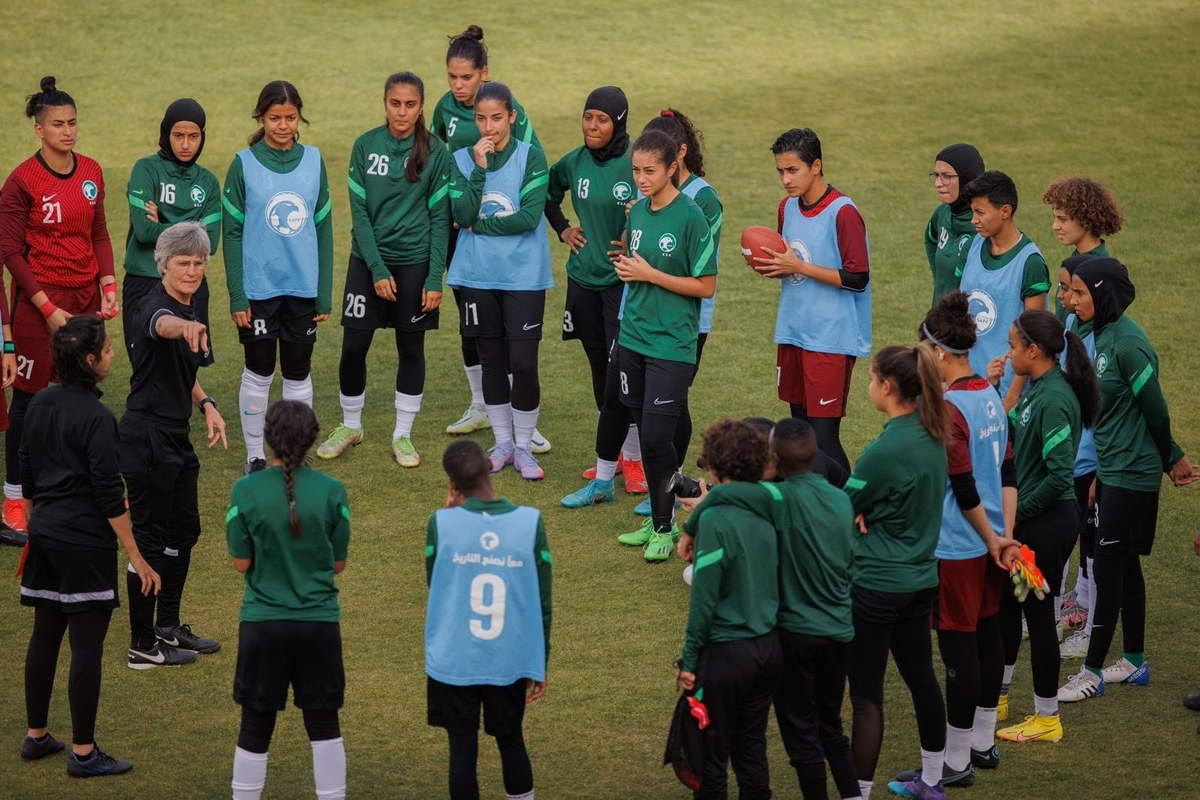Monika Staab has a dream that Saudi Arabia’s women’s national team will be among the world’s best within the next decade.
For the German coach, that could first be in an Asian competition, and then hopefully down the line at the World Cup.
And when that happens, we will look back on 2022 as the year that changed women’s football in the Kingdom forever.
In February, under the guidance of Staab, the national team played their first-ever internationals against the Maldives and Seychelles in Male. And earlier this month, they made more history by contesting their first two internationals on home soil, both against Bhutan in Riyadh.

(Right to left) Lamia Bahaian, Monika Staab, Aalia Al-Rasheed and Adwa Al-Arifi. (SAFF)
“It was another step for getting good experience for the national players, because that is what is lacking,” said Staab. “They don’t have many games, or they didn’t have any or many games in the past. So we have a wonderful two opening matches in the Maldives against Seychelles and the Maldives, which we both won 2-0. So we wanted to play in Bhutan but because of COVID-19 we couldn’t get into the country, it was difficult.”
“So then we decided to come to Saudi Arabia and play these two matches in Abha. And, of course, Bhutan was a very strong opponent, they had just played the South Asian Football Federation Cup. They came right after that tournament and played these games. And that was a real challenge for our team to play against them.”
The first match saw Saudi overturn a two-goal halftime deficit to draw 3-3, while the second ended in a 4-2 win for Bhutan.

(PHOTO: SAFF)
“I have to admit that Bhutan were really strong, knowing our strengths and playing a really good game. And our team was not quite as competitive as it was in the first game, but in the end lost 4-2, and I believe every loss every defeat, you can learn more out of it. And hopefully, it was a good lesson for the national players, about what we still have to do to be really competitive in the AFC Championship.”
Lack of match practice was another factor in those two matches, something that Staab is hoping will be addressed in coming months and years.
“The biggest problem was that when we finished our games in the Maldives, which was by the end of February, (at the time) they hadn’t played a match since actually the end of September. So we’re talking about almost seven months. They didn’t play 11-a-side,” said Staab.
“Twelve players were involved in the GCC futsal tournament in Kuwait and then the West Arab Championship in Jeddah in Saudi Arabia where they won the silver medal, which was a great success for them also. But they didn’t play 11-a-side, so we had a good training camp in Austria for almost 16 days and then for about 15 days we were in Abha to prepare for the two international games. But in the end, if you don’t play the real game, 11-a-side, it means the experience is still not there.”
Match experience no doubt will increase thanks to the launch of the eight-team Saudi Women’s Premier League earlier this month, alongside the 17-team First Division (formerly the Women’s Regional League).

(PHOTO: SAFF)
“So now I’m very, very happy the league has started, we saw some incredible matches in Jeddah, and here in Riyadh. So that is where most of the national players (are), they’re played in their clubs, which is great. So that’s where they are now getting experience week by week, to learn how to last for 90 minutes, to have in the last minute enough strength and endurance to play the game over 90 minutes.”
The establishment of these competitive league structures should lead to the emergence of more talented footballers across the country, she believes.
“It’s unbelievable,” said Staab. “It’s a fantastic opportunity for our coaches, assistant coaches to observe every week the players, the performance of the players we have selected. And also the players will be looking for, especially young players who I think they’re gonna come up. I saw in Al-Yamamah already two players which are very young, 15 years old. So that is what we will be looking for in this league, to have every weekend some maybe new players coming up, and especially the younger ones, because I think that’s the future.”
Staab also highlighted the role that the Saudi Arabian Football Federation has played, in particular the head of the Women’s Football Department Aalia Al-Rasheed and supervisor and board member Lamia Bahaian.
“And I’m so delighted and so happy this league has eventually started under Aalia and Lamia, they made everything possible, that this league is going to be played in a real league format, not just a tournament like we did last year.”
The standard of the new league has been boosted by the participation of five of the country’s biggest clubs — Al-Hilal, Al-Ittihad, Al-Nassr, Al-Shabab and Al-Ahli.

(PHOTO: SAFF)
“This is a great development because now we are looking at (teams) which can have the facilities, who are working very professionally, who are already established in Saudi Arabia because of the men’s team. And now they’re willing to put up the women’s game. I mean, it took Germany over 40 years before this happened — that a very, very strong men’s team in the first division put up a women’s team.”
“It’s just amazing what these women have done,” said Staab. “Adwa Al-Arifi, of course, from the Sports Ministry, she is also involved. They have played the game, Adwa, Lamia and Aalia, and they know what they are doing, and it is such a pleasure to work with them.”
Staab says that having a quota of foreign players, one that allows space for the development of Saudi players, is positive for the women’s game in general and should raise the standard of the local players.
Staab has also recommended the setting up of three regional training centers in Riyadh, Jeddah and Dammam that will look to unearth domestic talent, from ages 5 to 17. The aim is to produce Saudi age-group national teams in the future.
For now, the schedule for the senior Saudi team is about to get much busier too.

(PHOTO: SAFF)
“I made a calendar for the whole year. So we will have about 10 games in a year (2023),” said Staab. “That’s what we tried to fit in, that’s what (the) normal FIFA calendar gives.”
Several matches will soon be announced for the start of the new year ahead of another expected landmark date for Saudi women’s football.
“On the 31st of March 2023, you will see Saudi Arabia’s woman in the FIFA ranks and this is again another milestone, another big achievement for the women’s game in Saudi Arabia. I just talked to the President Yasser (Al-Misehal), he was very supportive, he said we need to play these games. They’re all very supportive (of) the women’s game.”
Staab has also proposed that a GCC Cup for women be established.
“I think this will happen soon because Kuwait is working on a young national team now. We had Oman … with their futsal team coming to Jeddah, the UAE have been very strong in the last few years. And also Bahrain since I established the national team in 2007. So they’ve been growing. So that will be fantastic to play the GCC men’s cup as well as the GCC women’s cup.”
Saudi Arabia is also bidding for the 2026 AFC Women’s Asian Cup, which would mark the Kingdom’s first participation in the competition’s 21st edition.
“This will (give us) another four years from now to have a strong team competing there, if they get the bid. So we will have to wait until April next year until this decision is made.”
Staab’s long-term plan is to play enough competitive international matches so that her national team will be competitive by 2026. The ambitions go beyond that, however.
“I’m not only in charge of the Regional Training Center, I want the young players coming up, because that is your basis, that is your foundation. I also took care of the coaching education,” said Staab.
“We have now done over 135 C-License coaches, 10 B-License coaches. Good coaches, especially female coaches mean you will be having better players,” she said. “So I’m really very keen on having good coaches, Saudi coaches, one day to take over everything, so we don’t need them all from abroad. That they get experience, that get monitored, they get kind of capability to develop as a coach because I still believe in women’s football and you need female coaches. It’s also for your culture, for your parents.”
“The officials are dreaming of going to the World Cup,” she added. “Of course it’s a big dream. I know Aalia, Adwa and Lamia would like to go as soon as possible, but probably not (in) 2027. We have 2031 or 2035, we have to see how the development goes, but I can see now we are running so fast.”
Staab says a foundation period of five years will eventually bear fruit.
“This is how you can achieve something,” she said. “If you work hard, if you’re determined, if you’re committed, and have this passion and all these people, and also the national players have this passion for the game. Let’s see how far in the end we will reach.
“I think everything will be possible here in Saudi Arabia.”














